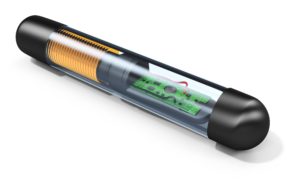Tracking fish & amphibians
Biologists have been trying to understand wildlife movement for decades. Until recently, tracking fish in water has been a very difficult task. However, with recent advances in GPS technology and tracking, they have a better understanding of movements and habitat use of aquatic species. Three tags are used to track fish movement in water:
Passive Integrated Transponder (PIT) tags
These are small glass encapsulated radio transponders that contain a specific code, which allows individual fish — as well as amphibians, reptiles, and birds — to be assigned a unique identification number. The tags use passive Radio Frequency Identification (RFID) technology, and its internal microchip only becomes active when it comes close to an antenna. When activated, the PIT tag transmits its unique code to the sensor and records the date and time of detection.

Radio tags
These tags convey a radio frequency signal that can be detected through one or more antennas and transceivers. The transmitter is attached to the fish and transmits radio signals to a radio receiver. Radio signals can be transmitted through the air or water; however, tagged fish are usually located by using an aerial antenna connected to the receiver.
Acoustic tags
These tags are similar to the radio tags. However, the acoustic signals use pressure waves that move through the water and not air. The antenna receiver, called a hydrophone, must be submerged in water to record the signals and determine the fish’s location.

Animations
Razorback sucker
The razorback sucker — a large, uniquely shaped fish — is native to the Colorado River Basin. It’s found nowhere else in the world. Over the decades, habitat changes and competition from non-native species hurt razorback sucker populations, and the species was listed as endangered in 1991. Since that time, multiple state and federal agencies have worked together and used hatchery-raised fish to help grow and restore razorback sucker populations. This animation tells the story of one hatchery-raised fish and its remarkable journey of nearly 1,000 miles over dams, through reservoirs and across state lines.
June sucker
The June sucker is an endangered species which inhabits Utah Lake. Found nowhere else in the world, this fish species has played an important role in the history of Utah Valley. June suckers were an important food source for the early Mormon pioneers who settled the area, and early accounts described millions of spawning suckers swimming up the Provo River each June. A steady decline in the population caused it to be listed as endangered under the Endangered Species Act in 1986, at which point there were only an estimated 300 individuals remaining.
Today, June suckers are on their way to recovery and were recently proposed for downlisting by the U.S. Fish and Wildlife Service from endangered to threatened. Thousands of individual fish inhabit the lake, and it is now common to see hundreds of spawning suckers while walking along the Provo River trail in May or June. For the past two decades, biologists have been using tracking tags to assess the survival and movement of June suckers in Utah Lake. These tags are implanted into fish and can then be detected by remote sensing equipment in Utah Lake and its tributaries. One individual has quite a history of movement around Utah Lake and into its tributaries. Find out more below.